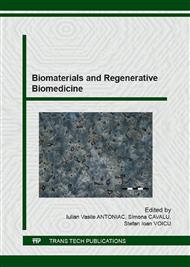[1]
A. Ahlbom, M. Feychting, Electromagnetic radiation, Br. Med. Bull. 68 (2003) 157-65.
Google Scholar
[2]
Information on: http: /www. who. int.
Google Scholar
[3]
N. Albert, M.F. Sherif, N.J. Papadopoulos, F. J. Slaby, J. Monahan, Effect of nonionizing radiation on the purkinje cells of the rat cerebellum, Bioelectromagnetics. 2 (1981) 247 – 257.
DOI: 10.1002/bem.2250020306
Google Scholar
[4]
N. Deliu, V. Calota, Campurile electromagnetice si efectele asupra starii de sanatate, Comunicatii Mobile – Revista afacerilor Telecom Mobile Media. 64 (2006).
Google Scholar
[5]
Information on: http: /jnci. oxfordjournals. org.
Google Scholar
[6]
B. Dindić, S. Radić, D. Krstić, D. Sokolović, D. Petković, T. Pavlović, J. Radosavljević, Exposure to electromagnetic field by using mobile telephones and its influence on the brain functions, Facta Universitatis. 2 (2004) 311 – 316.
Google Scholar
[7]
M. Mashevich, D. Folkman, A. Kesar, A. Barbul, R. Korenstein, E. Jerby, L. Avivi, Exposure of human peripheral blood lymphocytes to electromagnetic fields associated with cellular phones leads to chromosomal instability, Bioelectromagnetics. 24 (2003).
DOI: 10.1002/bem.10086
Google Scholar
[8]
M.B. Zhang, J.L. He, L.F. Jin, D.Q. Lu, Study of low-intensity 2450-MHz microwave exposure enhancing the genotoxic effects of mitomycin C using micronucleus test and comet assay in vitro, Biomed. Environ. Sci. 15 (2002) 283-290.
Google Scholar
[9]
A.A. Borbély, R. Huber, T. Graf, B. Fuchs, E. Gallmann, P. Achermann, Pulsed high frequency electromagnetic field affect human sleep and sleep electroencephalogram, Neurosci. Lett. 275 (1999) 207-210.
DOI: 10.1016/s0304-3940(99)00770-3
Google Scholar
[10]
Vijayalaxmi, K.S. Bisht, W.F. Pickard, M.L. Meltz, J.L. Roti, E.G. Moros, Chromosome damage and micronucleus formation in human blood lymphocytes exposed in vitro to radiofrequency radiation at a cellular telephone frequency (847. 74 MHz, CDMA), Radiat. Res. 156 (2001).
DOI: 10.1667/0033-7587(2001)156[0430:cdamfi]2.0.co;2
Google Scholar
[11]
Vijayalaxmi, L.B. Sasser, J.E. Morris, B.W. Wilson, L.E. Anderson, Genotoxic potential of 1. 6 GHz wireless communication signal: in vivo two-year bioassay. Radiat. Res. 159 (2003) 558–564.
DOI: 10.1667/0033-7587(2003)159[0558:gpogwc]2.0.co;2
Google Scholar
[12]
C. Goiceanu, Contributii la studiul influentei campurilor electromagnetice asupra sistemelor biologice, Univ. Al. I Cuza Iasi, Facultatea de Fizica, (2003).
Google Scholar
[13]
T.D. Utteridge, V. Gebski, J.W. Finnie, B. Vernon-Roberts, T.R. Kuchel, Long-term exposure of E-mu-Pim1 transgenic mice to 898. 4 MHz microwaves does not increase lymphoma incidence, Radiat. Res. 158 (2002) 357-364.
DOI: 10.1667/0033-7587(2002)158[0357:lteoep]2.0.co;2
Google Scholar
[14]
M.H. Repacholi, A. Basten, V. Gebski, D. Noonan, J. Finnie, A.W. Harris, Lymphomas in Eµ-Pim1 transgenic mice exposed to pulsed 900 MHz electromagnetic field, Radiat. Res. 147 (1997) 631 – 640.
DOI: 10.2307/3579630
Google Scholar
[15]
J.H. Bernhardt, Non-ionizing radiation safety: radiofrequency radiation, electric and magnetic fields. Phys. Med. Biol. 37 (1992) 807-844.
DOI: 10.1088/0031-9155/37/4/001
Google Scholar
[16]
Information on: http: /www. icnirp. org.
Google Scholar
[17]
H. Taskinen, P. Kyyrönen, K. Hemminki, Effects of ultrasound, shortwaves, and physical exertion on pregnancy outcome in physiotherapists, J. Epidemiol. Community. Health. 44 (1990) 196-201.
DOI: 10.1136/jech.44.3.196
Google Scholar
[18]
D.R. Black, L.N. Heynick, Radiofrequency (RF) effects on blood cells, cardiac, endocrine, and immunological functions, Bioelectromagnetics. 6: S1 (2003) 87-95.
DOI: 10.1002/bem.10166
Google Scholar
[19]
L. Kheifets, S. Oksuzyan, Exposure assessment and other challenges in non-ionizing radiation studies of childhood leukaemia, Radiat. Prot. Dosimetry. 132 (2008) 139-147.
DOI: 10.1093/rpd/ncn260
Google Scholar
[20]
H.Q. Zhang, W. Y Pan, Electromagnetic field of a vertical electric dipole on a perfect conductor coated with a dielectric layer, Radio Sci. 37 (2002) 131-137.
DOI: 10.1029/2000rs002348
Google Scholar
[21]
K.K. Karipidis, G. Benke, R. Malcolm Sim, K. Timo, G. Giles, Occupational exposure to ionizing and non-ionizing radiation and risk of glioma, Occup. Med. 57 (2007) 518-524.
DOI: 10.1093/occmed/kqm078
Google Scholar
[22]
L.J. Ravitz. History, measurement and applicability of periodic changes in the electromagnetic field in health and disease, Ann. N. Y. Acad. Sci. 98 (1962) 1144-1201.
DOI: 10.1111/j.1749-6632.1962.tb30626.x
Google Scholar
[23]
J.M. Aran, N. Carrere, Y. Chalan, P.E. Dulou, S. Larrieu, L. Letenneur, B. Veyret, D. Dulon, Effects of exposure of the ear to GSM microwaves: in vivo and in vitro experimental studies. Int. J. Audiol. 43 (2004) 245-254.
DOI: 10.1080/14992020400050069
Google Scholar
[24]
A. Auvinen, M. Hietanen, R. Luukkonen, R.S. Koskela, Brain tumours and salivary gland cancers among cellular telephone users, Epidemiology. 13 (2002) 356-359.
DOI: 10.1097/00001648-200205000-00018
Google Scholar
[25]
B. Wang, H. Lai, Acute exposure to pulsed 2450-MHz microwaves affects water-maze performance of rats, Bioelectromagnetics. 21 (2000) 52-56.
DOI: 10.1002/(sici)1521-186x(200001)21:1<52::aid-bem8>3.0.co;2-6
Google Scholar
[26]
L. Verschaeve, A. Maes, Genetic, carcinogenic and teratogenic effects of radiofrequency fields, Mutat. Res. 410 (1998) 141-165.
Google Scholar
[27]
G. Monfrecola, G. Moffa, E.M. Procaccini Non-ionizing electromagnetic radiations, emitted by a cellular phone, modify cutaneous blood flow, Dermatology. 207 (2003) 10-14.
DOI: 10.1159/000070934
Google Scholar
[28]
M. Mevissen, A. Lerchl, M. Szamel, W. Löscher, Exposure of DMBA-treated female rats in a 50-Hz, 50 microTesla magnetic field: effects on mammary tumor growth, melatonin levels, and T lymphocyte activation, Carcinogenesis. 17 (1996) 903-910.
DOI: 10.1093/carcin/17.5.903
Google Scholar
[29]
S. Aalto, C. Haarala, A. Brück, H. Sipilä, H. Hämäläinen, J. O Rinne, Mobile phone affects cerebral blood flow in humans, J. Cereb. Blood. Flow. Metab. 26 (2006) 885–890.
DOI: 10.1038/sj.jcbfm.9600279
Google Scholar
[30]
V. Rafnsson, E. Olafsdottir, J. Hrafnkelsson, H. Sasaki, A. Arnarsson, F. Jonasson, Cosmic radiation increases the risk of nuclear cataract in airline pilots: a population-based case-control study, Arch. Ophthalmol. 123 (2005) 1102–1105.
DOI: 10.1001/archopht.123.8.1102
Google Scholar
[31]
J. Miyakoshi, K. Takemasa, Y. Takashima, G.R. Ding, H. Hirose, S. Koyama, Effects of exposure to a 1950 MHz radio frequency field on expression of Hsp70 and Hsp27 in human glioma cells, Bioelectromagnetics. 26 (2005) 251-257.
DOI: 10.1002/bem.20077
Google Scholar
[32]
J.D. Jr Boice, R.E. Tarone, Cell phones, cancer, and children, J. Natl. Cancer. Inst. 103 (2011), 1211–1213.
Google Scholar
[33]
World Health Organization, Health issues related to the use of handheld radio telephones and base transmitters, International Commission on Non-Ionizing Radiation Protection (ICNIRP), Health Phys. 70 (1996) 587-593.
Google Scholar


